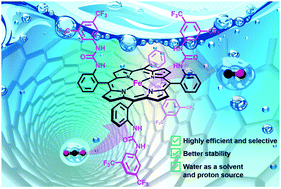Second-sphere hydrogen-bonding enhances heterogeneous electrocatalytic CO2 to CO reduction by iron porphyrins in water†
Abstract
Intense efforts are currently being devoted to discovering cost-effective catalysts for the selective reduction of carbon dioxide (CO2). Many advances have indeed been achieved in the design of molecular complexes containing second coordination chemical functionalities that have contributed to boosting the homogeneous electrocatalytic activity. The introduction of such chemical facets in heterogeneous catalysis is still lacking. Here, we report the electrocatalytic properties of a chemically modified electrode with a molecular iron-porphyrin catalyst holding urea functions (UrFe) in CO2 reduction, acting as a multipoint hydrogen bonding cleft to enhance CO2 binding. The immobilization of UrFe on multiwall carbon nanotubes (MWCNTs)/carbon paper (CP) allows the investigation of the catalytic performance in water. We found, herein, that the modified electrode displays excellent selectivity towards CO production in water, which is also acting as the sole proton source. Importantly, we observed one of the highest effective turnover frequency (eTOF) values (>21 s−1) at a potential of −0.78 V vs. RHE in comparison with similar modified electrode containing bare iron-porphyrin analogues. Our results therefore point to a remarkable gain in electrocatalytic performance of molecular catalysts at the surface of the electrodes with the added dimensionality of chemical functions operating as molecular clefts towards the binding and reduction of CO2.



 Please wait while we load your content...
Please wait while we load your content...